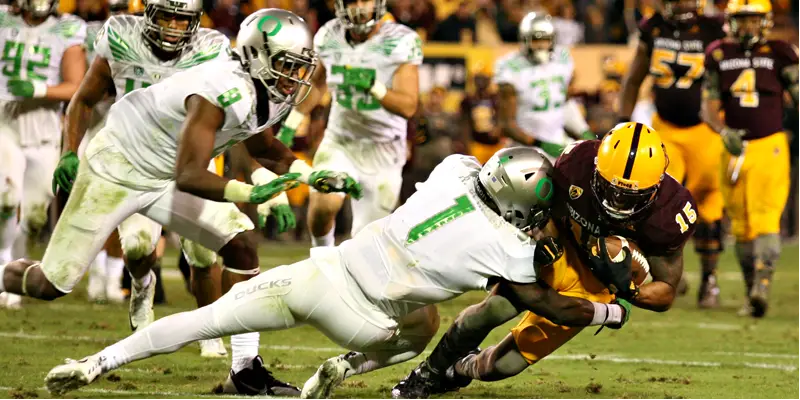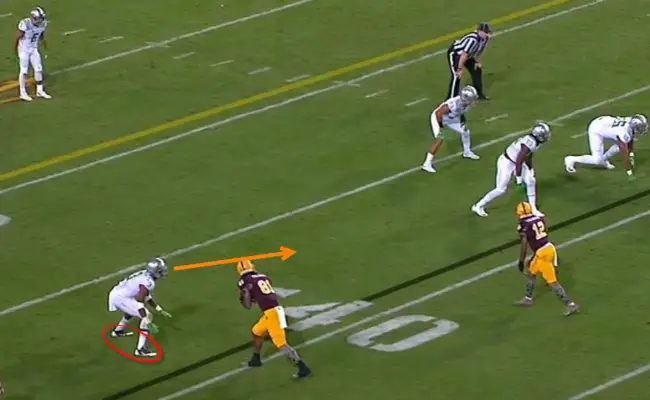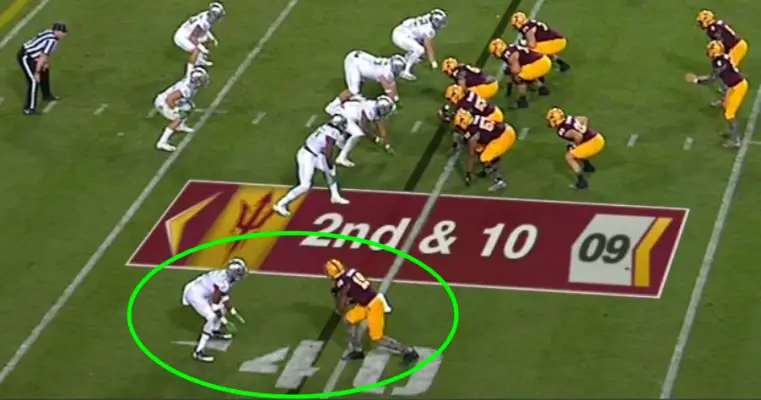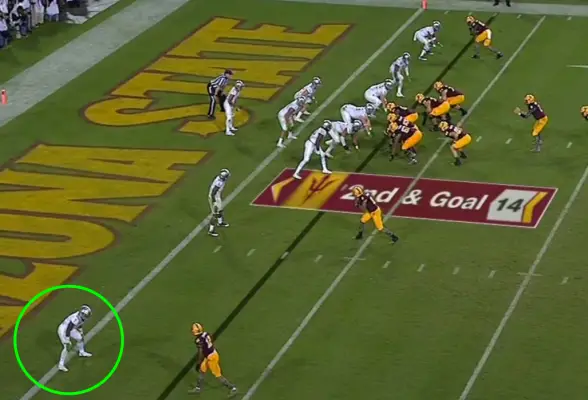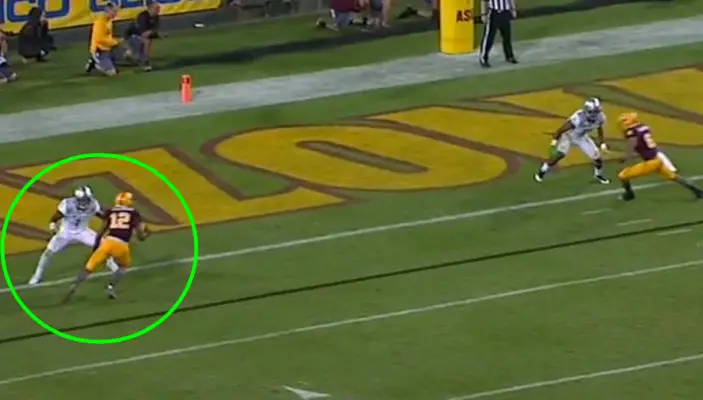The Oregon Duck defensive backs have been through a trial-by-fire season, where they have yielded a lot of yards and points. They have learned many tough lessons as a young — but still talented — crew. Through these trials and lessons, they also have steadily improved.
Will their improving skills and teamwork prove enough this coming week to vanquish one of the best passing attacks in the nation, the California Golden Bears?
To be effective, a defensive back (DB) needs to play man-on-man AND zone defense.
Man-on-man is more difficult than zone because the team is relying on you to completely shut down an individual receiver who might run anywhere on the field, with no help, as opposed to simply guarding an area in front of you and watching the quarterback’s eyes. They call it “playing on an island” for a reason.
This week’s analysis looks at good defensive back technique, whether in man-on-man coverage or zone. Coachup.com has some excellent material and much of the following draws from that site.
Objective No. 1 in man-on-man coverage is to not let the receiver gain separation, such that the QB can throw the ball over the DB’s head for an uncontested completion. To accomplish this, DBs must recognize different routes, as well as any “tells” a receiver has. They must also understand the importance of leverage and angles while playing in space.
In the photo above, Ugo Amadi is in a proper stance per coachup.com.
His feet are about shoulder width apart. His outside foot appears to be slightly behind his inside foot. He is bent forward at the waist, thus “hiding the numbers on his chest.”
Hopefully his eyes are facing the receiver (we can’t tell from this photo). His arms are bent, allowing him to be in a good backpedal position. A proper stance will put him in a good position to react to the receiver.
Coach and Athletic Director (coachad.com) says a very similar thing about the importance of stance. “Everything starts with a proper stance for your secondary players. Have them positioned in a staggered stance with a relaxed posture, hips low (like sitting in a chair) and hands in front of the body. Have them place more weight on the toes and less on the heels.”
As coachad.com further notes, “Secondary players’ eyes need to be focused on the offensive formation (the pre-snap read) and the player is ready for action when the quarterback begins his cadence.” Also, they advise “nose over the toes” while backpedaling.
In the photo above, Tyree Robinson looks like “press” man-on-man coverage with the receiver, No. 81. In reality, he is playing Cover 2 zone as indicated by his looking at the QB (orange arrow). He is up close so he can bump the WR.
Tyree has his feet about shoulder width apart, bent forward at the waist, arms bent, and his nose over his toes. He also has his outside foot far forward (circled in red), which, with his eyes facing toward the center of the field (orange arrow), is a clear indicator of zone.
His foot placement is to push the WR inward and let the safety, Charles Nelson, pick up the WR.
The video above shows the outcome of the play.
Tyree jammed the WR, but the WR bent back to deflect much of the force of the jam, keeping his center of gravity moving forward. The receiver could do this because Robinson’s jam contact was high above his center of gravity, near shoulder height. This was enough to get the needed separation from Tyree.
The photo above also shows Tyree looking toward the QB on the play, not at his man. He executed a decent jam on the receiver, but not good enough to force him inside. That was the crucial point. Then he turned his back to the WR.
As coachup.com notes, “The key to making contact on the WR is to not reach but to let them release into you. Try focusing on their numbers and step to meet the WR after they have declared the route direction. Reaching for the WR puts the DB off-balance and out of position to stay with the WR.”
Look at the video above again and decide for yourself if Tyree reached for the wideout.
In another play (see above), Tyree is squared up with the WR. If anything, his outside foot is a little back of the inside foot. His head is squarely focused on the wideout. This is a good stance. He is positioned to stop the WR from making a slant route.
As the WR heads downfield, Tyree doesn’t reach for the WR, he lets the WR release into him. This can be seen in the photo above by the dashed magenta line from Tyree’s feet up through his center of gravity.
The line is tilted slightly backward, indicating he is not reaching, but preparing to take in the WR on the release. The QB threw to the other side of the field on this play.
Sometimes even excellent coverage isn’t enough.
A well-executed play that has hurt the Ducks this season is the “slant” route. The WR takes a few steps downfield, then makes an abrupt cut across the center of the field. It is very hard to defend a slant when a QB makes a perfect pass.
The video above has Arrion Springs covering the slot receiver.
Arrion has a good stance (as described above). The WR cuts in on the slant. Arrion gives him a bump, and is right with him step for step.
He even arrives early, reaching his left arm out to deflect the pass and wrapping his right arm around the receiver (this could have been pass interference, but the outcome made that call pointless). Arrion tried to wrest the ball free, but the receiver hung on.
In the photo above, Springs is again lined up square with good stance (green circle). He is clearly focused on the WR, and is ready to go.
The WR makes his cut for the slant (see above). Arrion is in good position/stance to follow the receiver inside.
Above you see the play in motion. The slant by No. 12 has a close brush with No. 8 (possibly an intended pick play?). The receiver Arrion is covering doesn’t look like he’s going all out, sort of three-quarter speed, and soon the ball arrives.
While Arrion is in good coverage, he isn’t as close as on the first slant play described above. Yet he is ready and with the WR seeming to hold back a little, Arrion is in position to snag an interception.
Let’s look at this again with a second camera angle added.
Wow! Focusing on the DB play, I had to work this play over and over before I finally realized that Mike Bercovici was pressured by Rodney Hardrick on a blitz (watch the second replay on the video above).
Yes, I changed topic right here at the end, but I love a good blitz. It is very gratifying to see a defensive play called so rarely by the Ducks to disrupt an offensive play they’ve had such trouble with this season; especially when it seals a win.
Many thanks to coach Ryan Mitchell for his contributions to our understanding the Ducks. As the above analysis shows, the Duck DBs have improved this season, though there is still work to be done. Here’s to hoping these DBs prove their mettle against Goff, Hogan, Kessler, Collins, and whomever comes next.
“Oh how we love to learn about our beloved Ducks!”
Jay MacPherson
Oregon Football Analyst for CFF Network/FishDuck.com
Eugene, Oregon
Top image by David Pyles
I told my wife I might spin some yarn for FishDuck. She replied “You know nothing, Jay Mac.” She is probably correct, but since her name isn’t Ygritte, I’m jumping in. First off, you should know that I know almost nothing about football. Not the terminology, the techniques, the standards, the…wait for it…tradition. So I’m figuring at least I’ve got 1/4 of this covered from Duck perspective. Until two years ago at the age of 55, I played sports regularly. Much of it was Ultimate (that disc game, which is now officially recognized by the International Olympic Committee). So what? Well, in Ultimate, every player is a receiver, a cornerback/linebacker, and (to varying extents per play) a quarterback. The skills at getting open, at covering, at throwing (successfully) all apply to football. The object simply behaves differently while in flight. Oh, and there are the plays: getting people open, keeping opponents from getting open, etc. Thus, after playing a somewhat similar game for 33 years, and being a coach much of that time, I might know a little bit about player heart, techniques, and teamwork. I hope I can illuminate something new in Duck sports for you once in a while.

